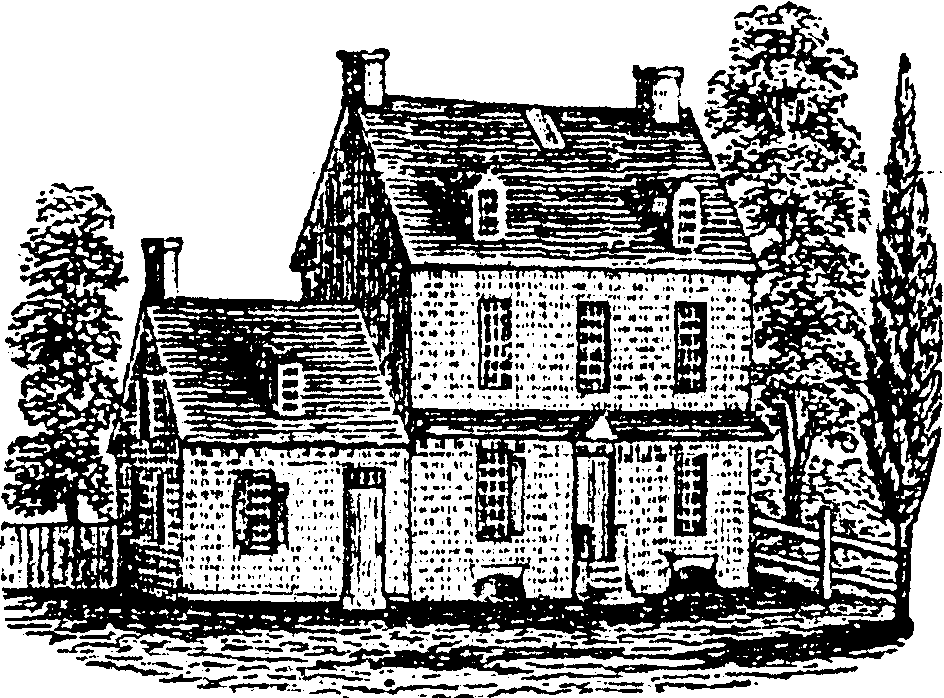

THE STORY OF THE HANCOCK HOUSE
3 FRONT STREET
HANCOCKS BRIDGE, NEW JERSEY
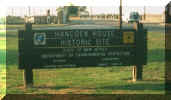 What a dynamic story the Friends of the Hancock House, Inc. in partnership with the NJDEP's Dept, of Parks & Forestry are prepared to offer our children
and the public! After five & a half years, these two groups are ready to "open
wide" the door to the study of early Salem County history.
What a dynamic story the Friends of the Hancock House, Inc. in partnership with the NJDEP's Dept, of Parks & Forestry are prepared to offer our children
and the public! After five & a half years, these two groups are ready to "open
wide" the door to the study of early Salem County history.
The story of the land on which the house was built is that of the Fenwick Colony and the settlement of New Salem. William Hancock was one of the investors who arrived to claim his land shortly after Fenwick's ship landed in 1675. Records indicate that William Hancock's share of the land was 968 acres in Alloways Creek, 16 acres in New Salem and 16 acres at Cohanzick, the site of the current day Greenwich in Cumberland County.
The new lands offered forests and marshes but more importantly, the promise of religious freedom. Just two years after his arrival, William Hancock died leaving only his widow Isabella and his indentured nephew John Hancock. Isabella soon sold 500 acres to John Maddox; the rest she left to her "indentured servant" John who was to work for another colonist named Wade for nine years to finally obtain his inheritance. John continued to live in the crudely built log structure, thought to have been built on the corner of the lawn of the later built Hancock House. Just before his death John constructed the first draw bridge over the Monmouth River (Alloways Creek) making possible the "turnpike" between Salem and Greenwich. The earliest settlers could only travel by water or on foot trails until these bridges were built. This is why we call the Alloways Creek the first turnpike.
John Hancock had 11 children & left his estate to his son William Hancock who was a very shrewd businessman. William moved to Elsinboro after marrying Sarah Thompson daughter of Joseph. This William went on to build the 1734 Hancock Mansion in Hancock's Hurst and later became a local Judge. The design of William and Sarah's mansion followed a type popular in Essex, England, an area the Fenwick colonists knew well. A master builder worked under William's watchful eye and materials were selected for their endurance and quality.
 The brick exterior is set in Flemish bond pattern which incorporates the
use of two types of bricks. On both ends of the house are nineteen zigzag
lines of blue and red bricks set in a pattern which if you look at steadily for
a full minute (even in a good photograph) suddenly appear to be gigantic
staircases to the sky, a troupe-l'oeil, a wonderful optical illusion!
The brick exterior is set in Flemish bond pattern which incorporates the
use of two types of bricks. On both ends of the house are nineteen zigzag
lines of blue and red bricks set in a pattern which if you look at steadily for
a full minute (even in a good photograph) suddenly appear to be gigantic
staircases to the sky, a troupe-l'oeil, a wonderful optical illusion!
The "blue" vitrified bricks achieved their hue from their composition and from their closeness to the fire in the oven where they were baked. Potassium nitrate in the clay rendered the blue color. Quality and size, even at that early date, was established by law.
Below the peak, at the north side of the house, is the letter "H" for Hancock; below the "H" to the left is "W" (William), to the right "S" Sarah, his wife. In the center is the date "1734".
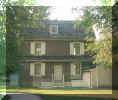 The plan of the house is simple: two large rooms below; two bedrooms
above. Boxed in circular staircases extend from cellar to attic, an unfinished
area with two dormer windows facing the creek. There is an additional room on
the south side, a part of the original house.
The plan of the house is simple: two large rooms below; two bedrooms
above. Boxed in circular staircases extend from cellar to attic, an unfinished
area with two dormer windows facing the creek. There is an additional room on
the south side, a part of the original house.
All over the globe, home designs come in a wide variety. Most probably, there are no two houses having the same exact design. Each house has something unique to offer in terms of flooring, doors used, wall finishes, and other interior decorations. But whatever the style is being used in designing houses, there will always be some objects that can serve as perfect matches to it, which are wooden doors .
Homeowners give high regard to the durability and strength of their houses, as well as everything included in it, which is why wood doors serve as essential piece of element in any home design. The materials used in wood doors are long lasting, can withstand severe weather conditions, and guarantee the look of elegance whether used as
exuding warmth and welcome to visitors as well as toughness and durability to dissuade would be intruders. The same advances in technology that brought about more material options for doors have made wooden doors much better.Each room has its own fireplace. The ground floor keeping room is the larger as both front and back doors open into it. It is here the cooking, spinning and other chores were done, the center of family life.
The two dormers on the third floor face the creek, the front of the house. The roof was, of course, made of cedar (shake) shingles. A small rectangular hatch opening on the roof was a safety feature. Fire always threatened.
A quotation from Mary T. Hewitt, many year curator and guide there, puts into words some details.
"A penthouse - commonly referred to as a 'pent—eave' - has been carried across both the front and back of the dwelling. In craftsmanship of The Hancock House we can see the quiet, austere Friends (Quaker) dominant throughout the Salem County area, for the Quaker built his doorway with simple self respecting trim, without side lights where the busy-body might peer therein, and with the most minute of entrance steps giving little encouragement to the loiterer. Glass, hand blown panes afford light over the front (and rear) doors. All the windows (12 over 12) on first and second levels have the hand blown glass." (probably mostly provided in the reconstruction.)
"The framing of the house is white oak, mortised and tenoned and doweled with wooden pins. A native heart-pine was used in the original paneled walls, mantles and wide random floor boards are original. Each room has its own fireplace. Three of the rooms have a little slip window (two panes over two panes) to light the closet on the side of the chimney and light is provided to the remaining closet by the authentic, hand carved and decorative grill - so often used in the early Salem County homes but rarely found intact after more than two hundred years - set in the paneling over the closet door in the Keeping Room."
The Hancock House is one of a number of outstanding houses built in those early days - a house distinguished since the day it was erected. It is amazing how many beautiful buildings still exist in our area, which were here at the time of the Revolution. How much was accomplished in those first hundred years in America!
It is not only for its age and beauty that the Hancock House must be preserved, but also for its place in history. This distinguished house was in 1778 the scene of an awful event - an important incident in New Jersey's Revolutionary War history.
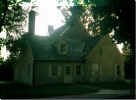 To tell the story, the stage must be set. The war had been going on for
a year and a half for the Declaration of Independence had been signed in
Philadelphia in 1776. The local population were about equally split in their
loyalties and the division was bitter. Some were for independence, others
for the Crown. The Quakers remained neutral. Young firebrands had gone to
serve Washington, the Commander in Chief, at once when independence was
declared. Soon more men were recruited by both sides. Those volunteers who
were loyal to the King were issued smart green uniforms and promised steady
payment each month. They marched off to join the British forces, the thousands
of trained soldiers from Britain and Scotland who sported red costs.
To tell the story, the stage must be set. The war had been going on for
a year and a half for the Declaration of Independence had been signed in
Philadelphia in 1776. The local population were about equally split in their
loyalties and the division was bitter. Some were for independence, others
for the Crown. The Quakers remained neutral. Young firebrands had gone to
serve Washington, the Commander in Chief, at once when independence was
declared. Soon more men were recruited by both sides. Those volunteers who
were loyal to the King were issued smart green uniforms and promised steady
payment each month. They marched off to join the British forces, the thousands
of trained soldiers from Britain and Scotland who sported red costs.
The Rebels had no such incentive. They served Washington's forces only because of their fervor to break the bonds with England. Local Rebels formed a home militia to protect the area in the event of an attack.
The Quakers traditionally took no stands. "Friends" to all, they continued their occupations, often serving in government. William Hancock, a Quaker, was a judge in the King's Court.
The winter of 1778 was unusually severe and cold. The British forces under General Howe had gathered in Philadelphia where they found comfortable, warm accommodations in the Quaker City. Nor did they lack for food, drink, or warm clothing. British ships sailed up the Delaware bringing supplies and reinforcements. Thousands of soldiers wintered in the city.
Washington and his forces were less fortunate in their situation at Valley Forge. Inadequately sheltered in rough-buildings, tents and sheds, the troops were miserable. They needed blankets, warm clothing and decent shoes. Food of any kind was scarce. Something had to be done for Washington's suffering soldiers or they would starve. The war would be lost without a battle.
Both Howe and Washington were aware that South Jersey was a "bread basket", a good source of supplies. Cattle and forage were there. The problem was one of procurement.
With nothing to offer but promises of payment in an uncertain future, Washington was compelled to send to the south east side of the river for supplies.
So it was that in the dead of winter, Washington commissioned Anthony Wayne to command a foraging expedition to go south to the east side of the Delaware - to South Jersey. Wayne's orders stipulated that careful records be maintained in order that payment for anything taken could be made later.
Wayne marched his troops, a force of 550 men, south. They circled Philadelphia without detection. His brigade was composed of the most physically fit, best clothed and shod of the force at Valley Forge.
On February 19th, they boarded small boats at Wilmington. Landing at Salem, detachments were sent out at once to collect cattle.
For three days they sought and gathered the cows, oxen and horses until they had more than 250 head. Then began America's first "cattle drive". At about eight miles a day, Wayne and his men drove the beasts up the King's Highway from Salem to Haddonfield and on to Burlington. At Trenton they- were forced across the river, over the ice and on to Valley forge. The beasts had provided their own transportation!
Shortly after leaving Salem, Wayne was informed that the British commander Colonel Mawhood was headed south. He and his men were assigned to counter Wayne's success and to secure food, especially meat, for the Tories in Philadelphia.
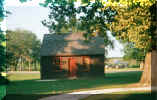 Anthony Wayne sent a message to Captain John Barry who was still in
Salem. "You are to pass up the River in your Boats, burn all the hay along
the shore from Billingsport to this place, taken account of Persons Names to
whom it belongs together with the Quantity."
Anthony Wayne sent a message to Captain John Barry who was still in
Salem. "You are to pass up the River in your Boats, burn all the hay along
the shore from Billingsport to this place, taken account of Persons Names to
whom it belongs together with the Quantity."
Fires were set along the shore of the Delaware. The smoke from the burning salt hay confused the British. They held up their departure for a day. This delay gave Wayne a good head start and allowed the cattle to proceed north without incident.
Later Washington confirmed that if the supply of cattle and forage had not been received the war would have been lost. Valley Forge would have marked the end of the Revolution.
The British, having failed in their attempt to halt Wayne's success, were more than ready to teach the militias a lesson and to break their spirits.
With forty ships on Salem Creek, and thirty on the Delaware, the British moved in. These forces under the command of Colonel Mawhood numbered from 1,500 to several thousand in their Red Coats and Green uniforms. They found haven in the Quaker homes in Salem. Who could resist such a force? They were accepted as inevitable.
Geography determined the defense set up by the militia.
The only access by land from Salem to the south requires the crossing of Alloway's Creek. Three roads led south; and each had a bridge. The three bridges had to be guarded; Hancock's Bridge, closest to the Delaware, Quinton Bridge at Quinton and Thompson's Bridge at Alloway.
The farmers who lived north of the Creek drove their cows and horses to the south side, and all three bridges were immediately placed under guard. At Quinton Bridge Colonel Elijah Hand, Commanding Officer of the Cumberland County Militia had ordered the defense - and was preparing to join the force there as soon as the march from Bridgeton could be made.
From Salem, the British commander, Colonel Mawhood, ordered advance patrols be sent to each of the three bridges. At Quinton Major Simcoe, in charge of a patrol, found The Rebels waiting for them. The draw of the bridge had been taken up. A small, little trained, rag-tag force under Captain William Smith guarded the bridge and believed they were ready for any attack.
The British fired without doing much damage. The locals responded. After a few rounds the British withdrew . . . and set up a trap for the locals. They forced the occupants of the nearby farm house to the cellar. Then troops were hidden in the house, in the bushes and in the tall reeds. Major Simcoe dispatched a line of soldiers back to the bridge. They fired a few shots. The Militia responded stoutly. The British retreated in haste and apparent disorder toward Salem.
Captain Smith's troops believed that they had repelled the enemy! Planks were hastily placed over the draw and the militia surged over the bridge. When they approached the farm house the British opened fire!
As many as could retreated over the planks, but seven were dead and seventeen captured that day.
At this point in time Colonel Hand and a substantial force arrived from Bridgeton with a cannon. The British retreated to Salem with their prisoners.
With Quinton Bridge out of use, the bridge at Hancock's Bridge still in Rebel control became a prime target. Closest to the river, it can be readily reached by land or water. Both Rebels and British were well aware of its importance.
A force of Rebel guards were assigned to protect it. All the day following the engagement at Quinton patrols watched along the roads and along the creek, searching for any sign of British attack. Evening came, still there was no sign of the enemy. No person was seen approaching or scouting in the area.
Judge Hancock's home is located within 300 yards of the bridge. He permitted the Rebel force to use his home as a barracks. Away days, he returned at night for his rest. As a Friend he was dedicated to peace, respected by both sides; a judge in the King's Court. The British had no desire to harm him.
Guards were set at the Bridge. A warning shot would bring aid. Guards were set at the doors of the house full of soldiers. The Rebel troops needed sleep and felt safe in taking it. No one knew what the morrow might bring. The weary soldiers expected trouble, but not at night. Again they underestimated the craft of the trained British commanders who plotted a surprise attack!
A British force, led by John Graves Simcoe, including men both from overseas and recruits from South Jersey, proceeded by ship from Salem in the dark of night. They sailed up the river as far as the tide permitted, but had not estimated the tide correctly, so they were forced to disembark on the south side of the marsh, well vest of their expected landing spot. They were probably carrying planks to stand on, pick up and replace as they vent along the river edge. They finally reached a dry path bordering the stream. A detail was sent ahead. They stole up, silently and bayoneted the guards before they could pick up their rifles and fire. No sound was heard in the house.
Simcoe's men quietly circled the house, half went to the front door, the others to the rear. Simultaneously, they forced their way in, bayoneting the guards and stabbing the Rebel soldiers, some of whom before the war had been their friends and neighbors. The only retreat was to the attic where the men were slain or sorely wounded. Blood stains remain on the floor. No gun was fired. No sound of ammunition exploding alarmed the little village. In all twenty were killed. Ten or twelve others sustained terrible wounds.
Old William Hancock was fatally wounded that sad night. He was carried to the nearly home of Joseph Ware who was also the son of a Fenwick colonist.
After the massacre, the British departed from South Jersey with the few cattle and other forage they had garnered. No cattle drive by foot for them! They sailed for Philadelphia on the ships on which they arrived.
This engagement marks the final invasion of our area. The French, persuaded by Benjamin Franklin, had come to the aid of the Revolutionists. The British feared that a French warship might enter the Delaware River; perhaps even a fleet! Their situation in Philadelphia was no longer tenable. The spring of 1778 marked a new phase in the war.
Following the massacre, the house changed hands several times. Deeds show:
11/27/1848 - From Nathaniel Stretch to R. Mulford - $4,200.00.
11/29/1884 - From Lucretta Mulford to W. S. Smith - $5,000.00.
12/09/1911 - From W. Scott Smith to Edmund Shimp - $3,500.00.
09/14/1931 - From Edmund Shimp to State of N. J. - $4,000.00.
The room at the southern side of the house was for many years known as Baker's Tavern where local people met and where travelers found food and drink. Little is known of its history.
 In 1931, The State of New Jersey acquired The Hancock House. Within a
year it was renovated and on May 4, 1932, Governor Moore dedicated the house
at a ceremony held at Hancock's Bridge. It was "The outstanding event in the
year in New Jersey, commemorating George Washington's birth."
In 1931, The State of New Jersey acquired The Hancock House. Within a
year it was renovated and on May 4, 1932, Governor Moore dedicated the house
at a ceremony held at Hancock's Bridge. It was "The outstanding event in the
year in New Jersey, commemorating George Washington's birth."
A letter of appeal, dated June 23, 1931 sent out by the Salem County Historical Society states - "It remains for the Salem County Historical Society to raise funds for restoration and furnishings." This must have been accomplished by the time of the opening ceremony when house tours were encouraged. A newspaper clipping records that the place was "furnished with many old relics all tending to enhance the colonial atmosphere of the old house."
1934 marks the next big event. On June 16th the Salem County Historical Society celebrated the "Date Marked - 1734". Again Governor Moore headed a list: of dignitaries who extended greetings and gave speeches." Demonstrations of old time industries, spinning, weaving, candle making, the forge in action, carpentry, chair making, etc., plus exhibits of Indian artifacts and early glassware were held on the grounds.
From 1932 on the house was open to the public. Children came by the bus load. History buffs arrived from all over the state and country. It was a distinguished historical destination. Guides conducted tours and told of the massacre which occurred there.
By 1975 it was determined that the time had come for a "complete, authentic reconstruction by the Department of Environmental Protection. The work began in 1976 and included an addition for the caretaker's quarters.
Bids came in at $304,552. Included were a new heating system and an air conditioning installation in the attic. (No more visitors were to see the stains on the floor). Everything was to be made right and authentic.
In 1979, four years later and at a cost of $375,000, the work was completed. No contractor had net his bid. In 1975 when the house was closed, the furnishings were "stored" at other "historical properties". They were never recovered. The local donors had understood that the furnishings were to be on permanent view at the house. They were disturbed.
Again, the Salem County Historical Society was left with the task of soliciting funds and authentic colonial furnishings. When this was accomplished, the house was again open to the public, resuming its place as a favored destination for school tours.
In 1975, a $350,000 expenditure program was started to renovate the NJ Sate owned property. A massive air conditioning unit placed in the center of the attic was the beginning of the restricted access to that area. The basement was soon filled with mechanical equipment. The Swedish Cabin was moved near the front of the house and converted to lavatories, while the flagpole and the SAR/SC* monument were moved to the rear of the house. The DAR** 1903 Memorial plaque was removed from the front of the house and discarded. Changes in the historical restoration laws and codes instituted since that time have served to rescue the Hancock House, once again. In 1996, all of these changes were corrected.
 In 1987, a new kitchen was added to the first floor of the apartment where
the caretaker-curator, Mary T. Hewitt and her family lived. She is remembered
for her knowledge of the house, its furnishings and its history, which she
enthusiastically shared with all visitors.
In 1987, a new kitchen was added to the first floor of the apartment where
the caretaker-curator, Mary T. Hewitt and her family lived. She is remembered
for her knowledge of the house, its furnishings and its history, which she
enthusiastically shared with all visitors.
By 1991, New Jersey was experiencing severe financial problems. Governor Florio ordered that this house and several other historical residences belonging to the State be closed as an economy measure. Mrs. Hewitt's job came to a sudden end! So did the school tours.
This time the entire collection was properly prepared for storage in archival materials and then stored at Parvin State Park. In 1995, a group of concerned local citizens formed an association dedicated to the re-opening of the Hancock House. The "Friends of the Hancock House, Inc." with Earl Pancoast as President, worked to incorporate and acquire non-profit status. For more than a year, the "Friends" had to spread the story while sitting outside on weekends. On March 21st, 1998, we had a very successful 220th commemoration of the Hancock House Massacre co-chaired by Ronald Magill and Doris Tice.
Today the house is open for tours on the 1st and 3rd Saturdays of the month from March through December and staffed by the Friends of the Hancock House. Between Memorial Day and Labor Day, seasonal workers based at Fort Mott staff the house from Wednesday through Sunday with a little help from the Friends. The Friends also do the school and group tours. The tours can be arranged by calling Fort Mott at 1-856-935-3218 with a request. Information about the activities sponsored by the Friends of the Hancock House can also be obtained by calling Fort Mott.


Friends of the Hancock House need volunteers for all phases of our
program.
The address is the:
Friends is Friends of the Hancock House, Inc.,
PO
Box 78,
Hancocks Bridge, NJ 08038
* Sons of the American Revolution of Salem County
** Daughters of the American Revolution
Rev 2001
 Copyright © 2001-
, Terry Muse
Copyright © 2001-
, Terry Muse
![]()